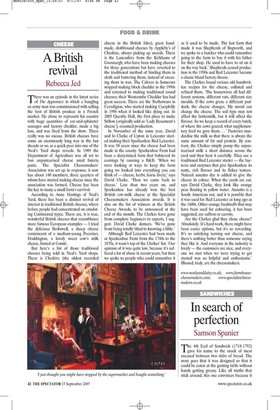A British revival
Rebecca Jed There was an episode in the latest series of The Apprentice in which a bungling ex-army man was commissioned with selling the best of British produce in a French market. He chose to represent his country with huge quantities of ear-and-sphincter sausages and factory cheddar, made a big loss, and was fired from the show. There really was no excuse. British cheeses have come an enormously long way in the last decade or so, as a quick peer into one of the Neal's Yard shops reveals. In 1989 the Department of Agriculture was all set to ban unpasteurised cheese amid listeria panic. The Specialist Cheesemakers' Association was set up in response; it now has about 140 members, three quarters of whom have started making cheese since the association was formed. Cheese has been the key to many a small farm's survival.
According to Anne Hastings of Neal's Yard, there has been a distinct revival of interest in traditional British cheeses, where before people had concentrated on emulating Continental types. There are, it is true, wonderful British cheeses that resemblance more famous European examples — I tried the delicious Berkswell, a sheep cheese reminiscent of a medium-young Pecorino; Doddington, a lovely sweet cow's milk cheese, hinted at Comte.
But here's a list of those traditional cheeses being sold in Neal's Yard shops. There is Cheshire (the oldest recorded cheese in the British Isles), great handmade, clothbound cheeses by Appleby's of Cheshire, always picking up awards. There is the Lancashire from the Kirkhams of Goosnargh, who have been making cheeses for three generations but have reverted to the traditional method of binding them in cloth and buttering them, instead of encasing them in wax. The Calvers in Somerset stopped making block cheddar in the 1990s and returned to making traditional round cheeses; their Westcombe Cheddar has had great success. There are the Trethowans in Ceredigion, who started making Caerphilly in 1996 when it looked like dying out. In 2005 Quenby Hall, the first place to make Stilton (originally sold as 'Lady Beaumont's cheese'), resumed production.
In November of the same year, David and Jo Clarke of Upton in Leicester started making their Sparkenhoe Red Leicester. It was 50 years since the cheese had been made in the county. Sparkenhoe Farm had been a dairy/mixed farm that bolstered its earnings by running a B&B. 'When we were looking at ways to keep the farm going we looked into everything you can think of — cheese, herbs, horse livery,' says David Clarke. 'Then we came back to cheese.' Less than two years on, and Sparkenhoe has already won the best British raw-milk cheese at the Specialist Cheesemakers Association awards. It is also on the list of winners at the British Cheese Awards, to be announced at the end of the month. The Clarkes have gone from complete beginners to experts, I suggest. David Clarke demurs. 'We've gone from being totally blind to knowing a little.'
Although Red Leicester had been made at Sparkenhoe Farm from the 1740s to the 1870s, it wasn't top of the Clarkes' list. 'Our opinion of it was quite low, because it's suffered a lot of abuse in recent years, but then we spoke to people who could remember it as it used to be made. The last farm that made it was Shepherds of Bagworth, and we spoke to a butcher who could remember going to the farm to buy it with his father for their shop. He used to have to sit on it on the way back.' Shepherds ceased production in the 1950s and Red Leicester became a classic bland factory cheese.
The Clarkes found various old handwritten recipes for the cheese, collated and refined them. 'The housewives all had different systems, different vats, different size moulds. If the cows graze a different paddock, the cheese changes. My mood can change the cheese. The soil type may not affect the buttermilk, but it will affect the flavour. So we keep a record of every batch, of where the cows grazed, what supplementary feed we gave them. . . ' Factories standardise the milk so that there is always the same amount of fat and protein. By contrast, the Clarkes simply pump the unpasteurised milk a short distance across the yard and then heat it carefully. They use a traditional Red Leicester starter — the bacteria and enzymes that give Sparkenhoe its nutty, rich flavour and its flakey texture. Natural annatto dye is added to give the cheese its colour. When the curds are cut, says David Clarke, they look like orange peas floating in yellow water. Annatto is a South American nut, and it is possible that it was used for Red Leicester as long ago as the 1600s. Other orange foodstuffs that may have been used for colouring, it has been suggested, are saffron or carrots.
Are the Clarkes glad they chose cheese? 'Absolutely. It's hard work, there might have been easier options, but it's so rewarding. It's so satisfying turning out cheese, and there's nothing better than someone saying they like it. And everyone in the industry is lovely — the customers are nice, and everyone we met when we were trying to get started was so helpful and enthusiastic.' Blessed, truly, are the cheesemakers.
www.nealsyarddany.co.uk; www.famthouse- cheesemakers.com; www.specialistcheese- makers.co.uk

























































 Previous page
Previous page